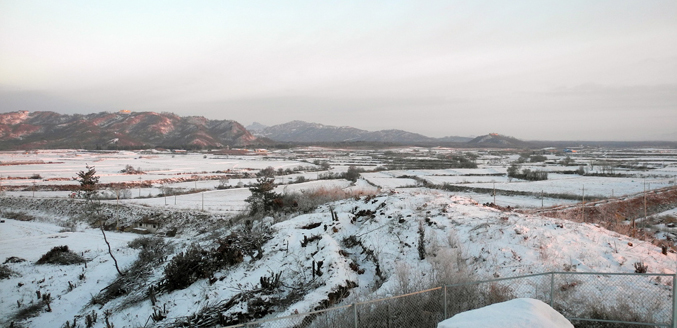Dr. Nial Moores, Birds Korea, January 28th
Part of the CCZ, Cheorwon County, December 2013 @ Birds Korea. Most of this area was “under construction” in January 2015
The demilitarized zone (DMZ) or inner Korean border is often portrayed as a vast wildlife-rich haven, a conservation diamond formed over several decades by the heat of war and tensions that afflict the Korean Peninsula: inaccessible, remote, natural. Although the DMZ has inadvertently become exceptionally important for biodiversity conservation, it is in effect only a thin ribbon of unpopulated land, a mere 4km wide, running 250km across country from close to Seoul in the west to Goseong County in the northeast.
This week, according to the Joongang Daily (January 27th ) and other domestic media, a government team from the ROK will attend a Ramsar Steering Committee meeting in Switzerland, to “promote its plan to create an ecological park inside the demilitarized zone (DMZ)”. Already, the Ministry of Unification “has conducted an initial site inspection in December with the support of civilian experts and other government offices, including the Ministry of Environment and the Ministry of Land, Infrastructure and Transport”.
Birds Korea is not involved in this potentially important process.
While fully respecting the authority and expertise of those involved at all levels of this process, it seems important to note that the DMZ is valuable primarily because it is the only extensive un-fragmented near-natural and natural habitat in central Korea. Without access to better information, it is hard to understand how its natural values (in terms of biodiversity and eco-services) can be improved by a large-scale construction project in a presumably core wildlife area.
Moreover, at least in the ROK, the DMZ runs parallel to an additional buffer of land, the Civilian Control Zone (CCZ). As proposed at a meeting of the DMZ Forum probably more than a decade ago, the CCZ offers the nation the best opportunity to develop habitat management approaches that could later be used in the DMZ. However, this has not happened. Instead, much of the CCZ is heavily utilized and even those areas long-known to support Ramsar-defined internationally important concentrations of globally Endangered Red-crowned Crane Grus japonensis and globally Vulnerable White-naped Crane Grus vipio are now undergoing extensive modification and degradation, including the conversion of semi-natural wetlands and terraced rice-fields into drier land for greenhouses and ginseng. As stated by Dr. Bernhard Seliger (Hanns Seidel Foundation, Korea) in a recent post on our joint visit to the CCZ, “one of the oldest protection areas in Korea, named ‘migratory pit stop’, a hot source never freezing in winter and formerly frequented by cranes, is currently a mere small pond near roads and hothouses…”
Those working for environmental conservation in the ROK are therefore left to wonder why areas in the CCZ that are already known to be internationally important for biodiversity have not been bought-up or at least subsidized by government bodies so that they can be managed appropriately, in order to maintain their ecological character and biodiversity values. This would of course be in accordance with commitments already made by the ROK to the Ramsar Convention, and also support the development of the expertise required to manage even more sensitive areas within the DMZ proper, including the proposed DMZ Eco-park.
Finally, it also seems necessary to note an apparent absence of robust monitoring data for eco-parks that were recently created during the Four Rivers project. Unaware of any evidence to the contrary, our own research, much of it dependent on data gathered by the national Ministry of Environment, shows clearly that many waterbird populations are in decline in the ROK, with these declines much greater at sites affected by the Four Rivers project than at sites that were not affected. As reported on page 40 of “Status of Birds, 2014”, “MOE Census data provide strong evidence that the Four Rivers project (2009-2011) caused large-scale declines in waterbirds at the site-level” and “caused large-scale declines in waterbirds at the national (and likely population) level”.
Figure showing changes in waterbird numbers by year recorded during the MOE winter Census, with the blue line indicating annual counts at the 48 sites in 2010 predicted by Birds Korea to be most impacted by the Four Rivers project; and the brown line indicating annual counts at the remaining unaffected 149 sites (From Status of Birds, 2014)
We can therefore only trust that those proposing and planning the Peace Eco-park in the DMZ will be well-supported by some of the world’s top experts, in order to ensure that the park fulfills both its peace and trust-building objectives and also those conservation obligations already held by the ROK under international conventions.


